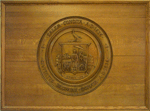House of the Seven Gables Settlement
According to the House of the Seven Gables website, "In the early 1900s, Salem witnessed an influx of immigrants, mostly of Polish and Eastern European descent. Recognizing the need for social services for the new Americans, Caroline O. Emmerton began a Settlement program to support and assist these new immigrants in their transition into American life and culture. Using Jane Addams’ Hull House in Chicago as her model, Emmerton's Settlement program focused on English language skills, vocational training, homemaking, nutrition, well-baby care, and early childhood education for the newly arriving immigrants and their children. Plays, pageants, and historical reenactments provided an understanding of American history and Salem’s place in the founding of the nation. For new immigrants, enrolling in these classes and programs meant making their way towards a better life in a new community.
To accomplish her social service work, Emmerton purchased the House of the Seven Gables, also known as the Turner Ingersoll Mansion, to generate revenue for her work. She purchased the house in 1908 and worked with historic preservation architect Joseph Chandler to transform the structure into a prime example of Colonial Revival architecture reflecting the tale outlined in Nathaniel Hawthorne’s novel, The House of the Seven Gables. Tourists flocked to The Gables to see the mansion and to learn more about Hawthorne and his life in Salem. Over the next 20 years, Emmerton purchased and restored more historic properties, adding to the site a collection of 17th, 18th, and 19th century structures."
Emmerton's settlement began in 1908 in the Seamen's Bethel, a small chapel donated by the Salem YMCA and located on the edge of the harbor in what is now the back yard of the House of the Seven Gables. Two years later, she bought the large house next door (the House of the Seven Gables), hoping to open it to visitors part of the year, expanding settlement programs and eventually using it as a residence for social workers. The settlement moved to a larger house on Turner Street in the 1930's and to its present location in Emmerton Hall in the late 1960's.
In the beginning, the settlement ran classes in English and citizenship for the newly arrived immigrants, and operated a medical clinic. It also offered programs in sewing, storytelling, gymnastics, cooking and woodworking. There was a glee club, a Little Folks Club, a travel club and a Neighborhood Social Club. The settlement ran a kindergarten long before the public schools. In the 1990's the settlement still ran a preschool, and after-school program, a day-care center, a summer camp, and programs for seniors.
